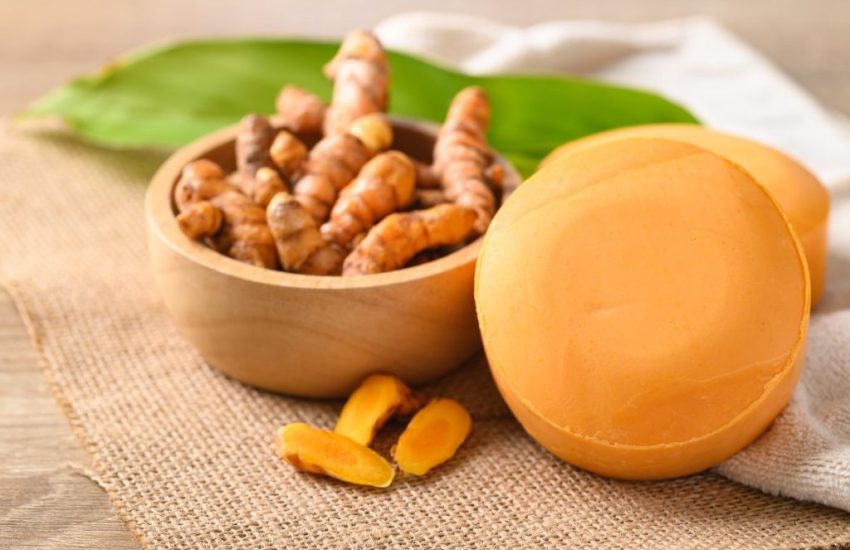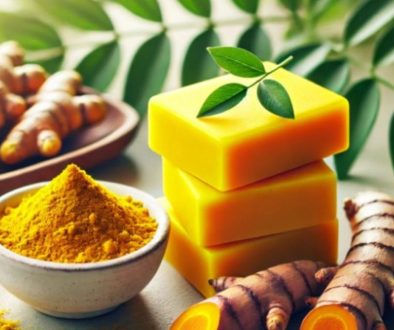Turmeric Soap Benefits: A Natural Way To Rejuvenate Your Skin

Published December 18, 2024
In the ever-changing world of skincare, are you frustrated with products that promise results but don’t deliver? One standout ingredient is turmeric. Known for its vibrant color and powerful properties, turmeric has become essential in modern skincare routines. Turmeric soap, in particular, is gaining popularity.
In this article, we’ll explore the fascinating history and numerous turmeric soap benefits. We’ll also learn how it can elevate your skincare routine.
What Is Turmeric?
Turmeric, or Curcuma longa, is a vibrant golden spice. It has been a cornerstone of Asian traditional medicine for over 6,000 years. Initially celebrated for its culinary and spiritual uses, it quickly emerged as a prized component in beauty routines.
Turmeric’s skincare effectiveness comes from curcumin, a powerful compound that gives it a rich color. Curcumin boasts anti-inflammatory and antioxidant properties, making it a sought-after ingredient for promoting skin health and vitality.

What Are The Benefits Of Using Turmeric Soap?
Turmeric soap is becoming famous for its skin benefits. It has anti-inflammatory, antibacterial, and antioxidant properties. It can improve complexion, reduce acne, and promote a healthy glow. Integrating it into your skincare regimen can lead to healthier, more vibrant skin.
Here are the critical turmeric soap benefits to consider if you’re thinking of using one soon:
Addressing Skin Conditions
Turmeric soap is a powerful ally in combating various skin conditions. Enriched with curcumin, the active compound in turmeric, this soap can help manage skin conditions such as psoriasis, dermatitis, and eczema. It has strong antimicrobial properties that effectively target skin infections. This natural remedy promotes healthier skin and greater comfort.
Regular use can soothe inflammation and help maintain skin balance, making it invaluable for those with persistent skin challenges.
Reducing The Visible Signs Of Aging
The anti-aging turmeric soap benefits for skin stem from its powerful antioxidant properties. Curcumin is a crucial component that effectively fights free radicals. These unstable molecules cause oxidative stress from environmental damage, including pollution and UV rays. This helps maintain a youthful glow.
Promoting Effective Wound Healing
Turmeric soap can speed up wound healing. Curcumin is crucial in collagen synthesis and is essential for skin strength and elasticity. This natural soap boosts the skin’s repair process. It’s beneficial for minor cuts, scrapes, and blemishes.
Turmeric has antimicrobial properties that help with healing. It prevents infections, reduces scarring, and promotes a healthier, rejuvenated appearance. Adding turmeric soap to your skincare routine provides a gentle and effective way to manage your skin after injury.

Fighting Acne
Curcumin’s strong antibacterial properties make turmeric soap a practical option for acne-prone skin. It targets bacteria such as Staphylococcus epidermidis and Propionibacterium acnes, often linked to breakouts. Turmeric soap helps reduce acne and prevent future blemishes by fighting these bacteria.
Turmeric soap’s anti-inflammatory effects soothe irritated skin, helping minimize redness and swelling often linked to acne flare-ups. Thus, it’s a powerful ally in the quest for clearer skin.
Minimizing Hyperpigmentation
Turmeric soap is known for its ability to even out skin tone and reduce hyperpigmentation. By inhibiting melanin production, it lightens dark spots and promotes a radiant complexion. With regular use, turmeric soap can reduce age spots and sun damage. It also helps even out skin tones, resulting in a smoother, more uniform appearance.
Its brightening effects also provide a healthy glow, making it a popular choice for enhancing natural beauty. Turmeric soap can boost your skincare routine and promote healthier, more vibrant skin.
Potential Drawbacks Of Turmeric Soap
Turmeric soap has several benefits. It features anti-inflammatory and antibacterial properties. However, these turmeric soap bar benefits might not be suitable for everyone. Some individuals may experience allergic reactions, such as contact dermatitis. This condition can lead to redness, itching, or swelling on the skin. This is especially important for those with sensitive skin or existing skin conditions.
Turmeric’s vibrant yellow color is aesthetically pleasing but can stain skin and clothing if left on too long or not rinsed properly. These stains can be challenging to eliminate and may need special treatment to avoid permanent marks.
It’s highly recommended to do a patch test on a small area of skin before full application. This ensures compatibility with your skin and lets you enjoy the benefits of turmeric soap without adverse reactions. Always consult a dermatologist if you’re unsure about adding new products to your skincare routine.

Integrating Turmeric Soap Into Your Skincare Routine
Adding turmeric soap to your skincare routine is both simple and effective. Swap your usual soap for a turmeric-infused alternative, using it to cleanse, exfoliate, and nourish your skin.
Pay attention to the ingredients. Some formulations may contain pore-clogging substances, such as coconut oil. If you have highly sensitive skin, perform a patch test to avoid adverse reactions.
Remember that everyone’s skin is unique, and consistency is essential when introducing new products into your regimen. Allow your skin time to adapt to the new product; you’ll soon experience the benefits of this ancient golden spice.
Frequently Asked Questions About Turmeric Soap
Is turmeric soap effective for reducing wrinkles?
Yes, turmeric soap can help reduce the appearance of wrinkles. Its antioxidant properties combat aging by neutralizing free radicals.
Can turmeric help eliminate dark spots?
Traditionally, turmeric has been used to improve skin complexion. It helps reduce pigmentation and is effective for gradually lightening dark spots.
How long should I leave turmeric soap on my skin?
To prevent staining, it’s best to rinse turmeric soap off your skin thoroughly after a few minutes of application.
Is it safe to use turmeric soap on my face daily?
Yes, you can use turmeric soap daily, but looking out for any signs of irritation is vital.
Which is more effective: kojic acid or turmeric?
Both kojic acid and turmeric offer distinct benefits. Kojic acid is used for intense pigmentation issues, while turmeric offers broader benefits for overall skin health.

Glow With Confidence: Rejuvenate Your Skin With Turmeric Soap
Turmeric soap is a versatile and natural addition to any skincare routine. It offers many benefits, including anti-aging and acne-fighting properties. By understanding the potential turmeric soap benefits and limitations, you can use turmeric soap to achieve a healthier, more radiant complexion. Embrace this time-honored remedy and allow your skin to shine with the wisdom of ancient traditions.
Unlock the Power of Turmeric With AMVital Products
Experience the transformative effects of AMVital’s meticulously formulated turmeric-infused products. Indulge in the luxurious goodness of our expertly crafted skincare and haircare range. Harness the incredible natural benefits of this golden spice and discover the remarkable power of turmeric. Explore our shop now and unlock radiant, healthier-looking skin and hair. Visit our shop to experience AMVital’s finest turmeric products.

This Content Has Been Reviewed For Factual Accuracy
The information presented here has been meticulously checked by our internal experts. To learn more about our rigorous editorial process, you can click here.

About The Author
I’m Corinne Grace, a passionate writer for AMVital.com. I create articles based on sound scientific evidence to help you make healthy decisions. As a nurse, I’ve been on the front lines, seeing the critical importance of accurate information.


